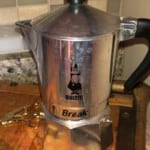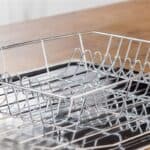There are many ways to make an excellent cup of coffee, and some coffee lovers have tried them all. While pour-overs, French presses, and expensive espresso machines are all top of mind, one of the most humble but quality coffee makers is the stovetop espresso maker known as the Moka pot.
This is a practical guide to Moka pots and how to choose the right one for your morning coffee routine.
How to Choose a Stovetop Espresso Maker
Before we get into how to choose a top-notch stovetop espresso maker, let’s learn what a Moka pot is, where they came from, and what qualities to look for when purchasing one.
Stovetop “espresso” makers do not make espresso the way a classic espresso machine does, but Moka pots will yield a strong, concentrated cup of coffee. A moka pot produces coffee that is two to three times as strong as drip coffee. In case a fancy espresso machine is not on your radar at the moment, then a stovetop espresso maker would be a good second choice.
Alfonso Bialetti received a patent from Italian inventor Luigi De Ponti in 1933. Even today, Bialetti’s basic design from 1933 is still used. Despite its humble appearance, the Moka pot is sturdy and reliable. Using them is simple, they require little cleanup, and they are very low maintenance.
Find Out Where It’s Made
Italy is a popular country for making stovetop espresso makers. Italian moka pots are a sure bet because they are high-quality and long-lasting. Moka pots made in China should be viewed with caution and you should research the brand. It has been reported that some Chinese stovetop espresso machines are toxic and of lower quality.
How Many Cups Can It Make?
Moka pots are designed for brewing small amounts of very strong coffee. Many small Moka pots are designed to make one shot-glass-sized cup of espresso, which could be perfect for one coffee lover, but definitely not for a crowd. You may want to purchase a stovetop espresso maker that brews multiple servings if you have several coffee drinkers in the house, as brewing coffee several times is tedious.
Is It Compatible With Your Stove?
See which kind of Moka pot works best with your stovetop before you buy. Gas stoves work better for some, while induction or electricity work fine for others. It is very likely that most Moka pots will work perfectly on an electric stove with a glass top.
Material: Aluminum vs. Stainless Steel
Stainless steel and aluminum are the most popular materials used for Moka pots, so which one is best? While stainless steel is more expensive, it will likely last longer than aluminum. Stainless steel makes a fine-looking Moka pot, but it also heats up quickly, so keep your hands away from it.
Aluminum is a cheaper metal, so while it might look less attractive than a stainless steel coffee pot, it also costs less. Aluminum conducts heat more slowly, so you are less likely to burn yourself.
Overall, stainless steel may be your best option. Investing in stronger, higher-quality metal for a moka pot is worth the money as they are already inexpensive.
How to Use a Stovetop Espresso Maker
With a Moka pot, you can make “espresso” shots that are simple and straightforward. What you need to do is as follows. To prepare a Moka pot, grind about 20 grams of coffee (for six cups) to a fine setting, just as you would grind espresso beans.
Add hot water to the lower chamber after boiling the filtered water.
Step 3: Fill the filter basket with ground coffee and place it in the lower chamber.
The upper chamber of the Moka pot is screwed on. There will be heat in the lower chamber.
Place the pan on the stovetop at medium heat. Steam is forced into the upper chamber as the hot water in the lower chamber heats up and boils. When the coffee has been hissing and bubbling for awhile, it is done.
How to Clean a Stovetop Espresso Maker
Moka pots are known for their sturdy, built-to-last designs, but they need to be gently cleaned. You should consider two things when cleaning a stovetop espresso maker: the finish of the pot, and the flavor of your coffee in the future (more on this below). Cleaning is easy and low-maintenance, however.
The finish of a Moka pot will be destroyed if you put it in the dishwasher. You can easily clean the Moka pot by disassembling it, washing and rinsing it with warm water, and letting it dry. There is no need or recommendation to use soap, since soap can actually alter the flavor of coffee.
Avoid using abrasive cleaners and sponges since they may damage the finish of the pot. Oils from the coffee will leave a thin film in the Moka pot after some time, seasoning the pot. Don’t scrub away the film. It actually makes your coffee taste better, so don’t get rid of it.
You should check the wear on the safety valve on the side of your stovetop coffee maker if you have had it for a long time (this device can really last decades if well cared for). A screw like this needs to be tightened and not too worn for safety reasons. Because these machines use steam under pressure, a worn safety valve could pose a safety hazard. In case you need recommendation for best stovetop espresso maker, we have list for it.
Was this helpful?
Hi there! I’m a food enthusiast and journalist, and I have a real passion for food that goes beyond the kitchen. I love my dream job and I’m lucky enough to be able to share my knowledge with readers of several large media outlets. My specialty is writing engaging food-related content, and I take pride in being able to connect with my audience. I’m known for my creativity in the kitchen, and I’m confident that I can be the perfect guide for anyone looking to take their culinary journey to the next level.








